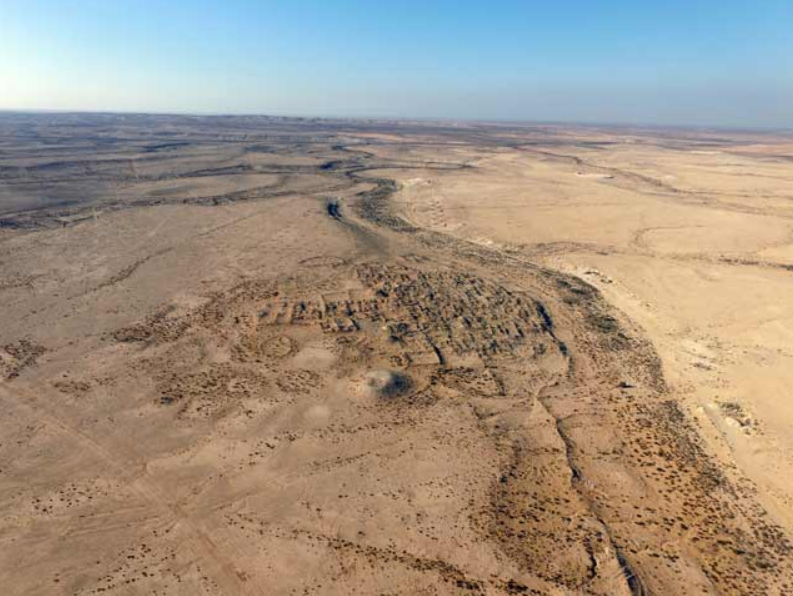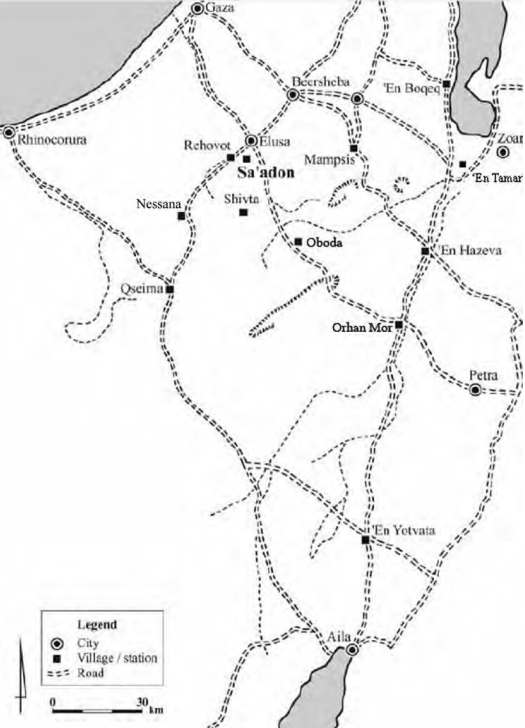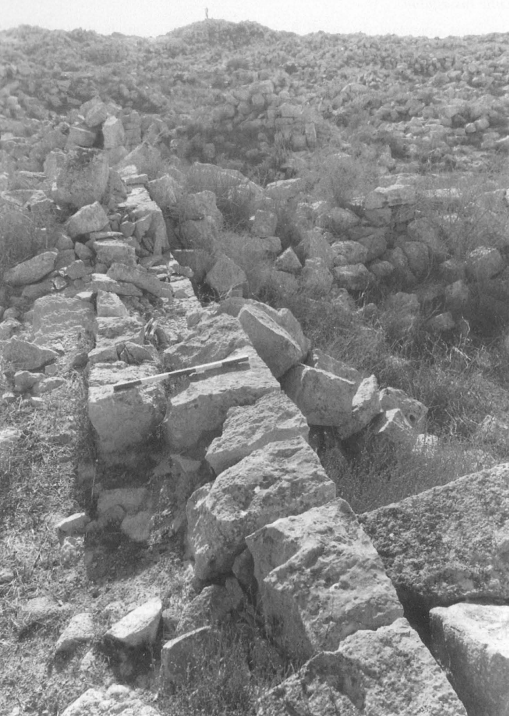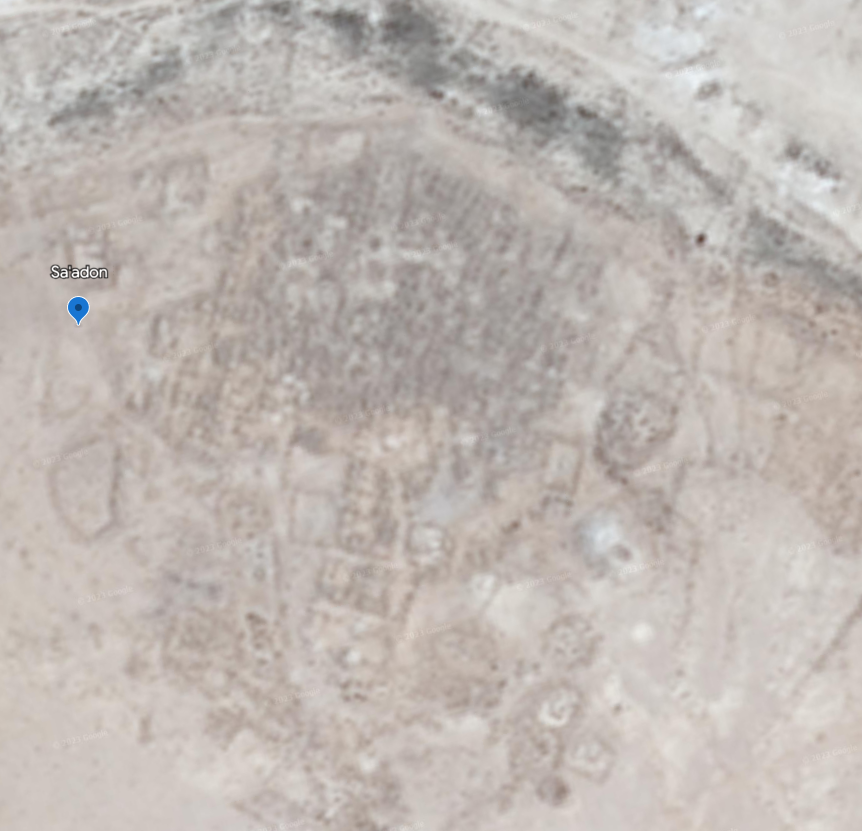Saadon
 Fig. 2
Fig. 2Aerial view of Horvat Sa’adon, looking looking west
Erickson-Gini (2018a)
| Transliterated Name | Source | Name |
|---|---|---|
| Saadon | ||
| Horvat Sa'adon | Hebrew | |
| Khirbet as-Sa'adi | Arabic | كهيربيت اسءسا'ادي |
| Sudanon | Greek | σuδανον |
| Sa'adu or Sa'adat | Nabataean |
Horvat Sa'adon, a Byzantine era village in the Negev, was located on a secondary route connecting Rehovot-in-the-Negev with Shivta (Erickson-Gini et. al., 2018). It may have been visited by the Anonymous pilgrim of Piacenza. Looting of the site in modern times may have obscured some archaeoseismic evidence.
- Fig. 1 - Location Map from
Erickson-Gini et. al. (2018)

 Fig. 1
Fig. 1
Map showing the location of Horvat Sa’adon with ancient road network
Erickson-Gini (2018) - Fig. 2a - Area Map from
Tepper et al. (2018)

 Fig. 2a
Fig. 2a
The hinterland surrounding the site, near wadi Saʻadon showing the location of [pigeon-raising] structures A–C
(after Hirschfeld 2006: fig 2)
Tepper et al. (2018) - Fig. 2 - Area Map from
Hirschfeld (2006)

 Fig. 2
Fig. 2
Map showing the location of Sa'aadon and its surroundings
Hirschfeld (2006) - Fig. 3 - Area Map from
Erickson-Gini et. al. (2018)

 Fig. 3
Fig. 3
Area Map
Erickson-Gini et. al. (2018)
- Fig. 2 - Aerial View from
Erickson-Gini et. al. (2018a)

 Fig. 2
Fig. 2
Aerial View of Horbat Sa'adon, looking west
Erickson-Gini (2018a) - Fig. 2 - Aerial View from
Erickson-Gini et. al. (2018)

 Fig. 2
Fig. 2
Aerial view of Horvat Sa’adon and Nahal Sa’adon facing west
(Image: G. Fitoussi, Israel Antiquities Authority).
Erickson-Gini (2018) - Saadon in Google Earth
- Saadon on govmap.gov.il
- Fig. 8 - Site Plan from
Hirschfeld (2006)

 Fig. 8
Fig. 8
Plan of Sa'adon with numbered dwelling units (1-51)
Hirschfeld (2006) - Fig. 14 - Plan and cross-section
of the south-western church Hirschfeld (2006)

 Fig. 8
Fig. 8
Plan and cross-section of the south-western church
Hirschfeld (2006) - Fig. 11 - Plan of the church
from Erickson-Gini et. al. (2018)

 Fig. 11
Fig. 11
Plan of the church
Erickson-Gini et. al. (2018) - Fig. 33 - Plan and cross-section
of the winepress from Hirschfeld (2006)

 Fig. 33
Fig. 33
Plan and cross section of winepress
Hirschfeld (2006)
- Fig. 8 - Site Plan from
Hirschfeld (2006)

 Fig. 8
Fig. 8
Plan of Sa'adon with numbered dwelling units (1-51)
Hirschfeld (2006) - Fig. 14 - Plan and cross-section
of the south-western church Hirschfeld (2006)

 Fig. 8
Fig. 8
Plan and cross-section of the south-western church
Hirschfeld (2006) - Fig. 11 - Plan of the church
from Erickson-Gini et. al. (2018)

 Fig. 11
Fig. 11
Plan of the church
Erickson-Gini et. al. (2018) - Fig. 33 - Plan and cross-section
of the winepress from Hirschfeld (2006)

 Fig. 33
Fig. 33
Plan and cross section of winepress
Hirschfeld (2006)
- Fig. 16 - Prayer niche
in the eastern part of the south-western church from Hirschfeld (2006)

 Fig. 16
Fig. 16
Prayer niche in the eastern part of the south-western church, view to the east
Hirschfeld (2006) - Fig. 18 - Prayer niche
(closeup) in the eastern part of the south-western church from Hirschfeld (2006)

 Fig. 18
Fig. 18
Prayer niche with place for reliquary casket, view to the east
JW: Note vertical fracture
Hirschfeld (2006) - Fig. 13 - Part of a painted
stone uncovered in front of the northern arched 'prayer' niche from Erickson-Gini et. al. (2018)

 Fig. 13
Fig. 13
Part of a painted stone uncovered in front of the northern arched 'prayer' niche.
Erickson-Gini et. al. (2018) - Fig. 13 - Part of a painted
stone uncovered in front of the northern arched 'prayer' niche from Erickson-Gini et. al. (2018a)

 Fig. 13
Fig. 13
Painted decoration on a stone
Erickson-Gini et. al. (2018a) - Fig. 12 - The southern wall
of the church, the square pillar and a blockage wall between them from Erickson-Gini et. al. (2018a)

 Fig. 12
Fig. 12
The southern wall of the church, the square pillar and a blockage wall between them, looking southwest
Erickson-Gini et. al. (2018a) - Fig. 24 - Repairs on
the northern wall of the church from Erickson-Gini et. al. (2018a)

 Fig. 24
Fig. 24
Repairs on the northern wall of the church, looking north
Erickson-Gini et. al. (2018a) - Fig. 21 - Tilted Wall
of House 22 from Hirschfeld (2006)

 Fig. 21
Fig. 21
Typical wall of a dwelling house (no. 22) in Sa'adon
JW: Wall is tilted
Hirschfeld (2006) - Fig. 22 - One of the
two types of retaining walls characterizing construction at Sa'adon from Hirschfeld (2006)

 Fig. 22
Fig. 22
[One of the] two types of retaining walls characterizing construction at Sa'adon
Hirschfeld (2006) - Fig. 23 - The other
type of retaining wall characterizing construction at Sa'adon from Hirschfeld (2006)

 Fig. 23
Fig. 23
[One of the] two types of retaining walls characterizing construction at Sa'adon
Hirschfeld (2006) - Fig. 32 - The winepress
from Hirschfeld (2006)

 Fig. 32
Fig. 32
The winepress, view to the north
Hirschfeld (2006)
| Phase | Start Date (c. CE) |
End Date (c. CE) |
Comments |
|---|---|---|---|
| 1 | 5th- early 6th | mid 7th |
Comments
|
| 2 | mid 7th | 8th |
Comments
|
| 3 | early 8th | early 8th |
Comments
|
Erickson-Gini et. al. (2018) reports that the [Southwestern] church was heavily damaged and subsequently repaired in the mid-7th
century CE and continued to be used for several years in the Umayyad period (mid-7th - 8th centuries CE)
.
- Erickson-Gini et. al. (2018) noted that walls aligned in a WNW direction were damaged.
| Effect | Location | Image(s) | Observation |
|---|---|---|---|
| Damage to prayer niche | Northern Prayer Niche in Southwestern Church
 Fig. 8
Fig. 8Plan and cross-section of the south-western church Hirschfeld (2006) 
 Fig. 11
Fig. 11Plan of the church Erickson-Gini et. al. (2018) |

 Fig. 16
Fig. 16Prayer niche in the eastern part of the south-western church, view to the east Hirschfeld (2006) 
 Fig. 18
Fig. 18Prayer niche with place for reliquary casket, view to the east JW: Note vertical fracture Hirschfeld (2006) 
 Fig. 13
Fig. 13Part of a painted stone uncovered in front of the northern arched 'prayer' niche. Erickson-Gini et. al. (2018) |
A partially destroyed northern prayer niche- Erickson-Gini et. al. (2018) |
| Displaced Walls surmised from Repairs | N Wall of Southwestern Church
 Fig. 11
Fig. 11Plan of the church Erickson-Gini et. al. (2018) |

 Fig. 24
Fig. 24Repairs on the northern wall of the church, looking north Erickson-Gini et. al. (2018a) |
Structural damage and repairs were revealed along the north wall of the church. The damage and subsequent repairs can be attributed to earthquake damage possibly in the mid-7th century CE.- Erickson-Gini et. al. (2018) |
| Displaced Walls surmised from revetment (support) wall | NW corner of Southwestern Church
 Fig. 11
Fig. 11Plan of the church Erickson-Gini et. al. (2018) |
The upper section of a revetment (support) wall testifying to repairs an the exterior surface exists along the northwest corner of the church.- Erickson-Gini et. al. (2018) |
|
| Displaced Walls surmised from blockage | S Wall Southwestern Church
 Fig. 11
Fig. 11Plan of the church Erickson-Gini et. al. (2018) |

 Fig. 12
Fig. 12The southern wall of the church, the square pillar and a blockage wall between them, looking southwest Erickson-Gini et. al. (2018a) |
In the second phase of occupation, the space between the square column and the southern wall was blocked and the blockage appears to have extended north of the column as well. ... The blockage of the space between the square column and the southern wall points to a contraction in the space of the church following the earthquake that required repairs in the northern wall.- Erickson-Gini et. al. (2018) |
| Wall Damage | S Wall in Western extension of the Southwestern Church
 Fig. 11
Fig. 11Plan of the church Erickson-Gini et. al. (2018) |
Excavation in the western extension of the church revealed damage to the southern wall that was apparently left partially unrepaired. However the pavement in the nave survived in situ.- Erickson-Gini et. al. (2018) |
|
| Broken wine press | NE bank of Nahal Sa'adon
 Fig. 2
Fig. 2Map showing the location of Sa'aadon and its surroundings Hirschfeld (2006) 
 Fig. 33
Fig. 33Plan and cross section of winepress Hirschfeld (2006) |

 Fig. 32
Fig. 32The winepress, view to the north Hirschfeld (2006) |
The `wine-press' hewn along the bedrock shelf on the northeast bank of Nahal Sa'adon was apparently broken by the same seismic event.- Erickson-Gini et. al. (2018) |
- Modified by JW from Fig. 11 of Erickson-Gini et. al. (2018)
 Deformation Map
Deformation Mapmodified by JW from Fig. 11 of Erickson-Gini et. al. (2018)
- Earthquake Archeological Effects chart
of Rodríguez-Pascua et al (2013: 221-224)

 Earthquake Archeological Effects (EAE)
Earthquake Archeological Effects (EAE)
Rodríguez-Pascua et al (2013: 221-224)
| Effect | Location | Image(s) | Observation | Intensity |
|---|---|---|---|---|
| Damage to prayer niche | Northern Prayer Niche in Southwestern Church
 Fig. 8
Fig. 8Plan and cross-section of the south-western church Hirschfeld (2006) 
 Fig. 11
Fig. 11Plan of the church Erickson-Gini et. al. (2018) |

 Fig. 16
Fig. 16Prayer niche in the eastern part of the south-western church, view to the east Hirschfeld (2006) 
 Fig. 18
Fig. 18Prayer niche with place for reliquary casket, view to the east JW: Note vertical fracture Hirschfeld (2006) 
 Fig. 13
Fig. 13Part of a painted stone uncovered in front of the northern arched 'prayer' niche. Erickson-Gini et. al. (2018) |
A partially destroyed northern prayer niche- Erickson-Gini et. al. (2018) |
VII+ |
| Displaced Walls surmised from Repairs | N Wall of Southwestern Church
 Fig. 11
Fig. 11Plan of the church Erickson-Gini et. al. (2018) |

 Fig. 24
Fig. 24Repairs on the northern wall of the church, looking north Erickson-Gini et. al. (2018a) |
Structural damage and repairs were revealed along the north wall of the church. The damage and subsequent repairs can be attributed to earthquake damage possibly in the mid-7th century CE.- Erickson-Gini et. al. (2018) |
VII+ |
| Displaced Walls surmised from revetment (support) wall | NW corner of Southwestern Church
 Fig. 11
Fig. 11Plan of the church Erickson-Gini et. al. (2018) |
The upper section of a revetment (support) wall testifying to repairs an the exterior surface exists along the northwest corner of the church.- Erickson-Gini et. al. (2018) |
VII+ | |
| Displaced Walls surmised from blockage | S Wall Southwestern Church
 Fig. 11
Fig. 11Plan of the church Erickson-Gini et. al. (2018) |

 Fig. 12
Fig. 12The southern wall of the church, the square pillar and a blockage wall between them, looking southwest Erickson-Gini et. al. (2018a) |
In the second phase of occupation, the space between the square column and the southern wall was blocked and the blockage appears to have extended north of the column as well. ... The blockage of the space between the square column and the southern wall points to a contraction in the space of the church following the earthquake that required repairs in the northern wall.- Erickson-Gini et. al. (2018) |
VII+ |
| Wall Damage | S Wall in Western extension of the Southwestern Church
 Fig. 11
Fig. 11Plan of the church Erickson-Gini et. al. (2018) |
Excavation in the western extension of the church revealed damage to the southern wall that was apparently left partially unrepaired. However the pavement in the nave survived in situ.- Erickson-Gini et. al. (2018) |
VII+ ? | |
| Broken wine press | NE bank of Nahal Sa'adon
 Fig. 2
Fig. 2Map showing the location of Sa'aadon and its surroundings Hirschfeld (2006) 
 Fig. 33
Fig. 33Plan and cross section of winepress Hirschfeld (2006) |

 Fig. 32
Fig. 32The winepress, view to the north Hirschfeld (2006) |
The `wine-press' hewn along the bedrock shelf on the northeast bank of Nahal Sa'adon was apparently broken by the same seismic event.- Erickson-Gini et. al. (2018) |
? |
Erickson-Gini, T. et. al. (2018a). Horvat Sa'adon - Preliminary Report Hadashot Arkheologiyot v. 130
Erickson-Gini, T. et. al. (2018). Horvat Sa'adon - Excavations in the Roman Tomb and Byzantine Church. London, The Society.
Hirschfeld, Y. 2006. Settlement of the Negev in the Byzantine period in light of the survey at Horvat Saʻadon. Bulletin of the Anglo-Israel
Archaeological Society 24: 7–49.
Tepper, Y., et al. (2018). "Pigeon-raising and sustainable agriculture at the fringe of the desert: a view from the Byzantine village of Sa‘adon, Negev, Israel." Levant 50.

